Africa[edit]
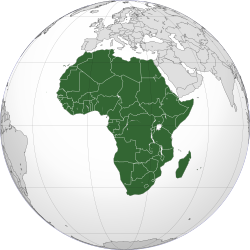 | |
| Area | 30,221,532 km2(11,668,599 sq mi) |
|---|---|
| Population | 2,032,532,974[1] (2011, 2nd) |
| Pop. density | 30.51/km2 (about 80/sq mi) |
| Countries | 57 (list of countries) |
| Languages | Languages of Africa |
| Time zones | UTC-1 to UTC+4 |
Main articles: Africa and List of sovereign states and dependent territories in Africa
Further information: Geography of Africa
For a table of sovereign states and dependent territories in Africa with geographical data such as area, population, and population density, see here.
Africa is the world's second-largest and second-most-populous continent. At about 30.2 million km² (11.7 million sq mi) including adjacent islands, it covers six percent of the Earth's total surface area and 20.4 percent of the total land area.[2] With 1.0 billion people (as of 2009, see table), it accounts for about 15% of the world's human population. The continent is surrounded by theMediterranean Sea to the north, both the Suez Canal and the Red Sea along the Sinai Peninsula to the northeast, the Indian Oceanto the southeast, and the Atlantic Ocean to the west. The continent includes Madagascar and various archipelagoes. It has 54 fully recognized sovereign states ("countries"), 10 territories and two de facto states with limited recognition.[3]
Africa, particularly central Eastern Africa, is widely accepted as the origin of humans and the Hominidae clade (great apes), asevidenced by the discovery of the earliest hominids and their ancestors, as well as later ones that have been dated to around seven million years ago – including Sahelanthropus tchadensis, Australopithecus africanus, A. afarensis, Homo erectus, H. habilis and H. ergaster – with the earliest Homo sapiens (modern human) found in Ethiopia being dated to circa 200,000 years ago.[4] Africa straddles the equator and encompasses numerous climate areas; it is the only continent to stretch from the northern temperate to southern temperate zones.[5] The African expected economic growth rate is at about 5.0% for 2010 and 5.5% in 2011.[6]
Asia[edit]
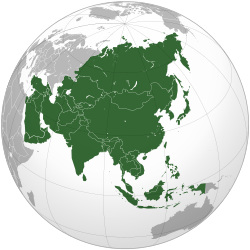 | |
| Area | 44,579,000 km2(17,212,000 sq mi)[7] |
|---|---|
| Population | 5,879,000,000 (1st)[8] |
| Pop. density | 87/km2 (225/sq mi) |
| Countries | 48 (list of countries) |
| Languages | List of languages |
| Time zones | UTC+2 to UTC+12 |
Main articles: Asia and List of sovereign states and dependent territories in Asia
Further information: Geography of Asia
For a table of sovereign states and dependent territories in Asia with geographical data such as area, population, and population density, see here.
Asia ( i/ˈeɪʒə/ or /ˈeɪʃə/) is the world's largest and most populous continent, located primarily in the eastern and northern hemispheres. It covers 8.7% of the Earth's total surface area (or 30% of its land area) and with approximately 4.3 billion people, it hosts 60% of the world's current human population. During the 20th century Asia's population nearly quadrupled.[9]
i/ˈeɪʒə/ or /ˈeɪʃə/) is the world's largest and most populous continent, located primarily in the eastern and northern hemispheres. It covers 8.7% of the Earth's total surface area (or 30% of its land area) and with approximately 4.3 billion people, it hosts 60% of the world's current human population. During the 20th century Asia's population nearly quadrupled.[9]
Asia is defined as comprising the eastwards four-fifths of Eurasia. It is located to the east of the Suez Canal, the Ural river, and theUral Mountains, and south of the Caucasus Mountains (or the Kuma-Manych Depression) and the Caspian and Black Seas.[10][11] It is bounded on the east by the Pacific Ocean, on the south by the Indian Ocean and on the north by the Arctic Ocean.
Given its size and diversity, Asia – a toponym dating back to classical antiquity – "is more a cultural concept" incorporating diverse regions and peoples than a homogeneous physical entity.[12] Asia differs very widely among and within its regions with regard to ethnic groups, cultures, environments, economics, historical ties and government systems.
- Notes
- The Russian Federation is classified as a European country by the United Nations Statistics Division. Russia is historically the successor of the Grand Duchy of Moscow, a medieval state of northeastern Europe. The Russian conquest of Northern Asia begins in the late 16th century. Today, most of the territory of Russia is in Asia, but most of its population lives in the European part.
Europe[edit]
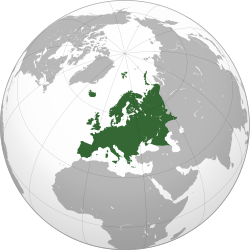 | |
| Area | 10,180,000 km2(3,930,000 sq mi)[n] |
|---|---|
| Population | 739,165,030[n] (2011), 3rd) |
| Pop. density | 72.5/km2 |
| Countries | 50 (list of countries) |
| Languages | List of languages |
| Time zones | UTC to UTC+6 |
Main articles: Europe and List of sovereign states and dependent territories in Europe
Further information: Geography of Europe
For a table of sovereign states and dependent territories in Europe with geographical data such as area, population, and population density, see here.
Europe ( i/ˈjʊərəp/ ewr-əp or /ˈjɜrəp/ yur-əp[13]) is, by convention, one of the world's seven continents. Comprising the westernmostpeninsula of Eurasia, Europe is generally divided from Asia by the watershed divides of the Ural and Caucasus Mountains, the Ural River, the Caspian and Black Seas, and the waterways connecting the Black and Aegean Seas.[14] Europe is bordered by the Arctic Ocean to the north, the Atlantic Ocean to the west, the Mediterranean Sea to the south, and the Black Sea and connected waterways to the southeast. Yet the borders of Europe—a concept dating back to classical antiquity—are somewhat arbitrary, as the primarily physiographic term "continent" can incorporate cultural and political elements.
i/ˈjʊərəp/ ewr-əp or /ˈjɜrəp/ yur-əp[13]) is, by convention, one of the world's seven continents. Comprising the westernmostpeninsula of Eurasia, Europe is generally divided from Asia by the watershed divides of the Ural and Caucasus Mountains, the Ural River, the Caspian and Black Seas, and the waterways connecting the Black and Aegean Seas.[14] Europe is bordered by the Arctic Ocean to the north, the Atlantic Ocean to the west, the Mediterranean Sea to the south, and the Black Sea and connected waterways to the southeast. Yet the borders of Europe—a concept dating back to classical antiquity—are somewhat arbitrary, as the primarily physiographic term "continent" can incorporate cultural and political elements.
Europe is the world's second-smallest continent by surface area, covering about 10,180,000 square kilometres (3,930,000 sq mi) or 2% of the Earth's surface and about 6.8% of its land area. Of Europe's approximately 50 states, Russia is by far the largest by both area and population, taking up 40% of the continent (although the country has territory in both Europe and Asia), while the Vatican City is the smallest. Europe is the third-most populous continent after Asia and Africa, with a population of 733 million or about 11% of the world's population.[15]
Europe, in particular Ancient Greece, is the birthplace of Western culture.[16] It played a predominant role in global affairs from the 15th century onwards, especially after the beginning of colonialism. Between the 16th and 20th centuries, European nations controlled at various times the Americas, most of Africa, Oceania, and large portions of Asia. In 1900, Europe's share of the world's population was 25%.[17] Both World Wars were largely focused upon Europe, greatly contributing to a decline in Western Europeandominance in world affairs by the mid-20th century as the United States and Soviet Union took prominence.[18] During the Cold War, Europe was divided along the Iron Curtainbetween NATO in the west and the Warsaw Pact in the east. European integration led to the formation of the Council of Europe and the European Union in Western Europe, both of which have been expanding eastward since the revolutions of 1989 and the fall of the Soviet Union in 1991.
- Notes
- Transcontinental countries in Europe and Asia, classified as West Asian countries by the United Nations Statistics Division:
 Azerbaijan,
Azerbaijan,  Georgia,
Georgia,  Turkey,
Turkey,  Armenia.
Armenia. - In West Asia, but a member of the European Union:
 Cyprus.
Cyprus.
- Transcontinental countries in Europe and Asia, classified as West Asian countries by the United Nations Statistics Division:
North America[edit]
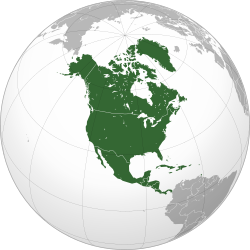 | |
| Area | 24,709,000 km2(9,540,000 sq mi) |
|---|---|
| Population | 528,720,588 (2008, 4th) |
| Pop. density | 22.9/km2 (59.3/sq mi)[b] |
| Countries | 23 (list of countries) |
| Languages | List of languages |
| Time zones | UTC-10 to UTC |
Main articles: North America and List of sovereign states and dependent territories in North America
Further information: Geography of North America
For a table of sovereign states and dependent territories in North America with geographical data such as area, population, and population density, see here.
North America is a continent wholly within the Northern Hemisphere and almost wholly within the Western Hemisphere. It is also considered a northern subcontinent of the Americas.[19] It is bordered to the north by the Arctic Ocean, to the east by the Atlantic Ocean, to the west and south by the Pacific Ocean, and to the southeast by South America and the Caribbean Sea.
North America covers an area of about 24,709,000 square kilometers (9,540,000 square miles), about 4.8% of the planet's surface or about 16.5% of its land area. As of July 2008, its population was estimated at nearly 529 million people across 23 independent states. North America is the third-largest continent in area, following Asia and Africa, and the fourth in population after Asia, Africa, and Europe.
South America[edit]
 | |
| Area |
17,840,000 km2
(6,890,000 sq mi) |
|---|---|
| Population | 387,489,196 (2011, 5th) |
| Pop. density | 21.4 per km2 (56.0 per sq mi) |
| Countries | 12 (list of countries) |
| Languages | List of languages |
| Time zones | UTC-2 to UTC-5 |
Main articles: South America and List of sovereign states and dependent territories in South America
Further information: Geography of South America
For a table of sovereign states and dependent territories in South America with geographical data such as area, population, and population density, see here.
South America is a continent located in the Western Hemisphere, mostly in the Southern Hemisphere, with a relatively small portion in the Northern Hemisphere.[20][21]
It is bordered on the west by the Pacific Ocean and on the north and east by the Atlantic Ocean; North America and the Caribbean Sea lie to the northwest. It is formed by twelve sovereign states - Argentina, Bolivia, Brazil, Chile, Colombia, Ecuador, Guyana,Paraguay, Peru, Suriname, Uruguay, and Venezuela - the French Guiana, which is an overseas region of France, and the Falkland Islands, a British Overseas Territory. In addition to this, the ABC islands of the Netherlands may also be considered part of South America, as well as Trinidad and Tobago. The South American states that border the Caribbean Sea – Colombia, Venezuela, Guyana, Suriname, and French Guiana – are also known as Caribbean South America.
South America has an area of 17,840,000 square kilometers (6,890,000 sq mi). Its population as of 2005 has been estimated at more than 371,090,000. South America ranks fourth in area (after Asia, Africa, and North America) and fifth in population (after Asia,Africa, Europe, and North America). The word America was coined in 1507 by cartographers Martin Waldseemüller and Matthias Ringmann, after Amerigo Vespucci, who was the first European to suggest that the lands newly discovered by Europeans were notIndia, but a New World unknown to Europeans.
Oceania[edit]
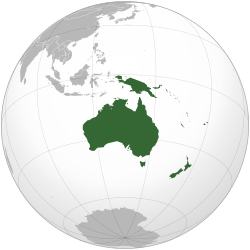 Geopolitical Oceania | |
| Area |
8,560,000 km2
(3,310,000 sq mi) |
|---|---|
| Population | 38,304,000 (2013, 5th) |
| Pop. density | 4.47 per km2 (11.57 per sq mi) |
| Countries | 14 (list of countries) |
| Languages | List of languages |
| Time zones | UTC-2 to UTC-5 |
Main articles: Oceania and List of sovereign states and dependent territories in Oceania
See also: Australia (continent) and Pacific Islands
Further information: Geography of Oceania
For a table of sovereign states and dependent territories in Oceania with geographical data such as area, population, and population density, see here.
Australia (UK /ˌoʊʃɪˈɑːnɪə/ or /ˌoʊsɪˈɑːnɪə/;[22] US /ˌoʊʃiːˈæniːə/)[23] is a region centered on the islands of the tropical Pacific Ocean.[24]Opinions of what constitutes Oceania range from the coral atolls and volcanic islands of the South Pacific (ethnologically divided into the subregions of Melanesia, Micronesia, and Polynesia)[25] to the entire insular region between Asia and the Americas, includingAustralasia and the Maritime Southeast Asia.The term is sometimes used more specifically to denote a continent comprisingAustralia and proximate islands,[26][27][28][29] or biogeographically as a synonym for either the Australasian ecozone (Wallacea andAustralasia) or the Pacific ecozone (Melanesia, Polynesia, and Micronesia apart either from New Zealand[30] or from mainland New Guinea).[31]
Antarctica[edit]
 | |
| Area | 14,000,000 km2 (5,400,000 sq mi)[32] |
|---|---|
Main article: Antarctica
Further information: Geography of Antarctica
Antarctica ( i/æntˈɑrtɨkə/ or /ænˈtɑrktɨkə/)[d] is Earth's southernmost continent, containing the geographic South Pole. It is situated in the Antarctic region of the Southern Hemisphere, almost entirely south of the Antarctic Circle, and is surrounded by the Southern Ocean. At 14.0 million km2 (5.4 million sq mi), it is the fifth-largest continent in area after Asia, Africa, North America, and South America. For comparison, Antarctica is nearly twice the size of Australia. About 98% of Antarctica is covered by ice that averages at least 1 mile (1.6 km) in thickness.
i/æntˈɑrtɨkə/ or /ænˈtɑrktɨkə/)[d] is Earth's southernmost continent, containing the geographic South Pole. It is situated in the Antarctic region of the Southern Hemisphere, almost entirely south of the Antarctic Circle, and is surrounded by the Southern Ocean. At 14.0 million km2 (5.4 million sq mi), it is the fifth-largest continent in area after Asia, Africa, North America, and South America. For comparison, Antarctica is nearly twice the size of Australia. About 98% of Antarctica is covered by ice that averages at least 1 mile (1.6 km) in thickness.
Antarctica, on average, is the coldest, driest, and windiest continent, and has the highest average elevation of all the continents.[35]Antarctica is considered a desert, with annual precipitation of only 200 mm (8 inches) along the coast and far less inland.[36] The temperature in Antarctica has reached −89 °C (−129 °F). There are no permanent human residents, but anywhere from 1,000 to 5,000 people reside throughout the year at the research stations scattered across the continent. Only cold-adapted organisms survive there, including many types of algae, animals (for example mites, nematodes, penguins, seals and tardigrades), bacteria,fungi, plants, and protista. Vegetation where it occurs is tundra.
Although myths and speculation about a Terra Australis ("Southern Land") date back to antiquity, the first confirmed sighting of the continent is commonly accepted to have occurred in 1820 by the Russian expedition of Fabian Gottlieb von Bellingshausen and Mikhail Lazarev on Vostok and Mirny. The continent, however, remained largely neglected for the rest of the 19th century because of its hostile environment, lack of resources, and isolation. The Antarctic Treaty was signed in 1959 by 12 countries; to date, 49 countries have signed the treaty. The treaty prohibits military activities and mineral mining, prohibits nuclear explosions and nuclear waste disposal, supports scientific research, and protects the continent's ecozone. Ongoing experiments are conducted by more than 4,000 scientists from many nations.
Antarctica is regulated by the Antarctic Treaty System, which defines it as all land and ice shelves south of 60°S, and has no government and belongs to no country. However, the following territorial claims in Antarctica have been made:
- Argentina: Argentine Antarctica
- Australia: Australian Antarctic Territory
- Brazil: Brazilian Antarctica (unofficial)
- Chile: Antártica
- France: Adélie Land
- New Zealand: Ross Dependency
- Norway: Peter I Island and Queen Maud Land
- United Kingdom: British Antarctic Territory
- (Unclaimed: Marie Byrd Land)
Moreover, the following dependent territories are situated in the wider Antarctic Region:
See also[edit]
Currencies of the World| Country | Currency | Sub Currency |
| Afghanistan | afghani | 100 puls |
| Algeria | dinar | 100 centimes |
| Andorra | euro | 100 cents |
| Argentina | peso | 100 centavos |
| Australia | dollar | 100 cents |
| Austria | euro | 100 cents |
| Bahamas | dollar | 100 cents |
| Bahrain | dinar | 1,000 fils |
| Barbados | dollar | 100 cents |
| Belgium | euro | 100 cents |
| Belize | dollar | 100 cents |
| Benin | franc | 100 centimes |
| Bolivia | boliviano | 100 centavos |
| Brazil | real | 100 centavos |
| Brunei | dollar | 100 cents or sen |
| Bulgaria | lev | 100 stotinki |
| Cameroon | franc | 100 centimes |
| Canada | dollar | 100 cents |
| Cayman Islands | dollar | 100 cents |
| Central African Rep. | franc | 100 centimes |
| Chad | franc | 100 centimes |
| Chile | peso | 100 centavos |
| China | yuan | 10 fen |
| Columbia | peso | 100 centavos |
| Congo | franc | 100 centimes |
| Costa Rica | colon | 100 centimos |
| Cuba | peso | 100 centavos |
| Cyprus (Greek) | euro | 100 cents |
| Cyprus (Turkish) | lira | 100 kurus |
| Czechoslovakia | koruna | 100 halers |
| Denmark | krone | 100 ore |
| Djibouti | franc | 100 centimes |
| Dominican Rep. | peso | 100 centavos |
| Ecuador | dollar | 100 cents |
| Egypt | pound | 100 piastres |
| El Salvador | colon | 100 centavos |
| Ethiopia | birr | 100 cents |
| Fiji | dollar | 100 cents |
| Finland | euro | 100 cents |
| COUNTRY | CURRENCY | SUB CURRENCY |
| France | euro | 100 cents |
| Gabon | franc | 100 centimes |
| Gambia | dalasi | 100 bututs |
| Germany | euro | 100 cents |
| Ghana | cedi | 100 pesewas |
| Greece | euro | 100 cents |
| Guatemala | quetzal | 100 centavos |
| Guinea | franc | 100 centimes |
| Guyana | dollar | 100 cents |
| Haiti | gourde | 100 centimes |
| Honduras | lempira | 100 centavos |
| Hong Kong | dollar | 100 cents |
| Hungary | forint | 100 filler |
| Iceland | Krona | 100 aurar |
| India | rupee | 100 paise |
| Indonesia | rupiah | 100 sen |
| Iraq | dinar | 1,000 fils |
| Ireland | euro | 100 cents |
| Israel | shekel | 100 agorot |
| Italy | euro | 100 cents |
| Ivory Coast | franc | 100 centimes |
| Jamaica | dollar | 100 cents |
| Japan | yen | 100 cen |
| Jordan | dinar | 1,000 fils |
| Kenya | shilling | 100 cents |
| Kuwait | dinar | 1,000 fils |
| Lebanon | pound | 100 piastres |
| Luxembourg | euro | 100 cents |
| COUNTRY | CURRENCY | SUB CURRENCY |
| Malawi | kwacha | 100 tambala |
| Malaysia | ringgit | 100 sen |
| Maldives | rufiyaa | 100 laari |
| Malta | euro | 100 cents |
| Mauritania | ouguiya | 5 khoums |
| Mauritius | rupee | 100 cents |
| Mexico | peso | 100 centavos |
| Mongolia | tugrik | 100 mongo |
| Montenegro | euro | 100 cents |
| Morocco | dirham | 100 centimes |
| Nepal | rupee | 100 paisa |
| Netherlands | euro | 100 cents |
| New Zealand | dollar | 100 cents |
| Nicaragua | cordoba | 100 centavos |
| Niger | franc | 100 centimes |
| Norway | krone | 100 ore |
| Oman | riyal-omani | 1,000 baiza |
| Pakistan | rupee | 100 paisa |
| Papua New Guinea | kina | 100 toea |
| Paraguay | guarani | 100 centimos |
| Peru | inti | 100 centimes |
| Philippines | peso | 100 centavos |
| Poland | zloty | 100 groszy |
| Portugal | euro | 100 cents |
| Qatar | riyal | 100 dirhams |
| Romania | leu | 100 bani |
| Saudi Arabia | riyal | 100 dirhams |
| Senegal | franc | 100 centimes |
| Serbia | dinar | 100 paras |
| Seychelles | rupee | 100 cents |
| COUNTRY | CURRENCY | SUB CURRENCY |
| Sierra Leone | leone | 100 cents |
| Singapore | dollar | 100 cents |
| Slovakia | koruna | |
| Slovenia | euro | 100 cents |
| Solomon Islands | dollar | 100 cents |
| Somalia | shilling | 100 cents |
| South Africa | rand | 100 cents |
| South Korea | won | 100 chon |
| Spain | euro | 100 cents |
| Sri Lanka | rupee | 100 cents |
| Sudan | dinar | |
| Suriname | guilder | 100 cents |
| Sweden | krona | 100 ore |
| Switzerland | franc | 100 centimes |
| Syria | pound | 100 piastres |
| Taiwan | dollar | 100 cents |
| Tanzania | shilling | 100 cents |
| Thailand | baht | 100 satang |
| Togo | franc | 100 centimes |
| Trinidad & Tobago | dollar | 100 cents |
| Tunisia | dinar | 1,000 millimes |
| Turkey | lira | 100 kurus |
| Uganda | shilling | 100 cents |
| United Arab Emir. | dirham | 1,000 fils |
| United Kingdom | pound | 100 pence |
| United States | dollar | 100 cents |
| Uruguay | peso | 100 centesimos |
| Venezuela | bolivar | 100 centimos |
| Vietnam | dong | 100 xu |
| Western Samoa | tala | 100 sene |
| Zambia | kwacha | 100 ngwee |
| Zimbabwe | dollar | 100 cents |
.jpg)
No comments:
Post a Comment
Note: Only a member of this blog may post a comment.